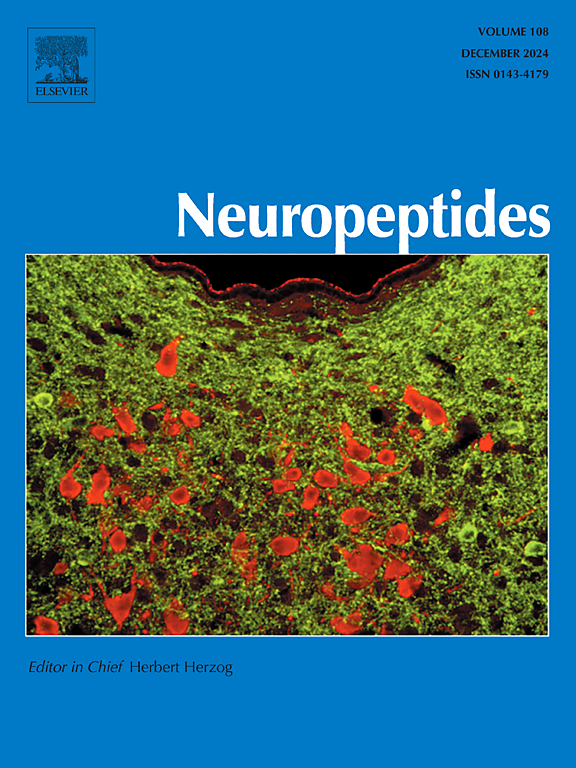Interaction of glucocorticoids and interleukins in the control of hypothalamic neurohypophysial system output in salt loaded male rats
IF 2.7
3区 医学
Q3 ENDOCRINOLOGY & METABOLISM
引用次数: 0
Abstract
The present study investigated the effects of a 4-day salt load (0.3 M NaCl, SL) and dexamethasone treatment (DEXA, 1 mg/Kg, subcutaneous) on the mechanisms possibly underlying glucocorticoid-mediated effects on hypothalamic neurohypophyseal system (HNS) activity. As expected, SL animals developed hyperosmolality, reflecting the progressive increase in plasma sodium concentrations. SL also triggered increased hypothalamic expression of vasopressin (AVP) and oxytocin (OT) messenger RNAs (mRNAs), increased magnocellular neuronal activation, and enhanced plasma hormone concentrations. Plasma corticosterone, interleukin (IL) 1β and tumor necrosis factor alfa, but not IL-6 levels, were also elevated in response to SL. Increased salt consumption also significantly decreased hypothalamic mRNA expression for the p65 subunit of the nuclear factor kappa B (NFkB), and increased mRNA expression for type β NFkB inhibitory protein (IκBβ). The protein expression ratio between phosphorylated and total NFκB was also elevated in SL rats. DEXA administration, in turn, prevented SL-induced AVP and OT release, as well as decreased corticosterone/IL plasma levels. Therefore, the present results suggest that increased salt consumption may originate a systemic-driven pro-inflammatory response, which can contribute to the increased secretion of corticosterone observed in SL animals. We therefore hypothesize that elevated systemic IL levels, in parallel with corticosterone secretion, may constitute, besides hyperosmolality, important redundant stimuli triggering SL-induced neuropeptide release. Conversely, high levels of corticosterone would produce, in the long term, inhibition of HNS activity and the termination of the neurosecretory response.
糖皮质激素和白细胞介素在盐负荷雄性大鼠下丘脑神经垂体系统输出控制中的相互作用
本研究探讨了4天盐负荷(0.3 M NaCl, SL)和地塞米松治疗(DEXA, 1 mg/Kg,皮下)对糖皮质激素介导的下丘脑神经垂体系统(HNS)活性影响的可能机制。正如预期的那样,SL动物出现了高渗透压,反映了血浆钠浓度的逐渐增加。SL还引发下丘脑抗利尿激素(AVP)和催产素(OT)信使rna (mrna)表达增加,大细胞神经元活化增加,血浆激素浓度升高。血浆皮质酮、白细胞介素(IL) 1β和肿瘤坏死因子α (IL -6)水平也随盐摄入增加而升高,同时下丘脑核因子κB (NFkB) p65亚基mRNA表达显著降低,β型NFkB抑制蛋白(i - κBβ) mRNA表达显著升高。在SL大鼠中磷酸化与总NFκB蛋白的表达比例也升高。DEXA给药,反过来,阻止sl诱导的AVP和OT释放,并降低皮质酮/IL血浆水平。因此,目前的研究结果表明,盐摄入量的增加可能引起系统性的促炎反应,这可能导致在SL动物中观察到的皮质酮分泌增加。因此,我们假设,除了高渗透压外,与皮质酮分泌平行的全身IL水平升高可能构成触发sl诱导的神经肽释放的重要冗余刺激。相反,从长远来看,高水平的皮质酮会抑制HNS活性并终止神经分泌反应。
本文章由计算机程序翻译,如有差异,请以英文原文为准。
求助全文
约1分钟内获得全文
求助全文
来源期刊

Neuropeptides
医学-内分泌学与代谢
CiteScore
5.40
自引率
6.90%
发文量
55
审稿时长
>12 weeks
期刊介绍:
The aim of Neuropeptides is the rapid publication of original research and review articles, dealing with the structure, distribution, actions and functions of peptides in the central and peripheral nervous systems. The explosion of research activity in this field has led to the identification of numerous naturally occurring endogenous peptides which act as neurotransmitters, neuromodulators, or trophic factors, to mediate nervous system functions. Increasing numbers of non-peptide ligands of neuropeptide receptors have been developed, which act as agonists or antagonists in peptidergic systems.
The journal provides a unique opportunity of integrating the many disciplines involved in all neuropeptide research. The journal publishes articles on all aspects of the neuropeptide field, with particular emphasis on gene regulation of peptide expression, peptide receptor subtypes, transgenic and knockout mice with mutations in genes for neuropeptides and peptide receptors, neuroanatomy, physiology, behaviour, neurotrophic factors, preclinical drug evaluation, clinical studies, and clinical trials.
 求助内容:
求助内容: 应助结果提醒方式:
应助结果提醒方式:


